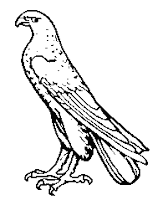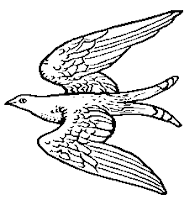Heraldic fauna fall into 6 classifications: beasts,
birds, fish, insects, monsters, and reptiles.
In early heraldry there were very few animals used, mainly the lion, but
over the years the selection grew to several dozen animals that were popular to
use. The tables below show the different
postures you may find when looking at arms.
Four Legged
Animals, Beasts, or Monsters
Four legged creatures are some of the more common charges
found. Examples of these are: bear, dog,
dragon, lion, stag, and tiger.|
Posture
|
Definition
|
Example
|
|
Rampant (rearing)
|
Body erect, forelegs apart and out, back rear leg off
ground
|
|
| Salient (leaping) |
Body erect and elongated, forelegs out and together,
rear legs together on ground
|
|
|
Courant (running)
|
Body elongated, head erect, all four legs extended
|
|
|
Passant (walking)
|
Body horizontal, head angled or erect, three feet
touching ground with right foreleg raised
|
|
|
Statant (standing)
|
Body horizontal, head angled or erect, all four feet
touching the ground
|
|
|
Sejant (sitting)
|
Body angled, head erect, all four legs touching the
ground, rear legs tucked, front legs straight
|
|
|
Sejant Erect (sitting upright)
|
Body and head erect, rear legs tucked, forelegs apart
and out
|
|
|
Couchant (lying down)
|
Body horizontal, head erect with legs tucked under body
|
|
|
Dormant (sleeping)
|
Body horizontal, legs tucked under body, and head down
in a sleeping position
|
|
|
|
|
There are three divisions of avians within this category: raptors, general birds, and special birds. The three most common raptors are the eagle, falcon, and owl. Each have a position that is commonly associated with them: displayed for the eagle, rising and close for the falcon, and close guardant for the owl. In the general bird group you will find commonly the crow, duck, and martlet. The default position for these birds is close. Special birds have positions that are unique to them and no other birds. These would pride for the peacock, vigilance for the crane, and piety for the pelican.
Birds have wing positions like beasts have head
positions. They can be used by
themselves or combined when explaining the position of the bird’s wings. I listed the wing positions first because
they can be used to define the body posture of the bird as well.
|
Posture
|
Definition
|
Example
|
|
Addorsed
|
Both wings on same side of body
|
|
|
Displayed
|
Wings on either side of body
|
|
|
Elevated
|
Wingtips away from body
|
|
|
Inverted
|
Wingtips tucked back towards body
|
|
|
Displayed
|
Wings and legs splayed
|
|
|
Close
|
Wings close against the body and feet on the ground
|
|
|
Volant
|
Feet invisible, wings outstretched, wings may or may
not be displayed
|
|
|
Rising
|
Feet on ground, wings elevated or displayed, addorsed
or not
|
|
|
Close affront (close guardant)
|
Normally only for owls also known as close guardant
|
|
|
Pride
|
Seen only with Peacocks, close affront with tail
feathers displayed
|
|
|
Vigilance
|
Seen only in cranes, close with one leg raised, stone
in claw
|
|
|
Piety (or vulning)
|
Seen only in pelicans, normally with nest and chicks
|
|
In the next post I will go through fish, insects, and reptiles. These are very interesting because there are
specific terms associated with each that are not used to describe other
animals.























Interesting blog. Very informative.
ReplyDelete